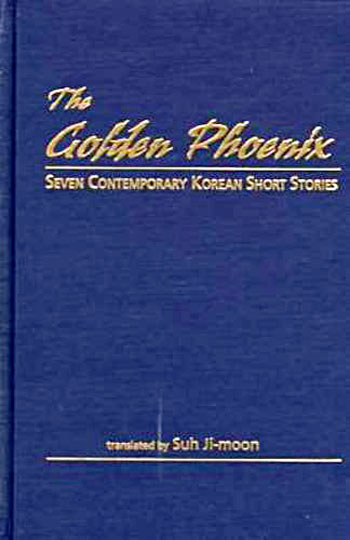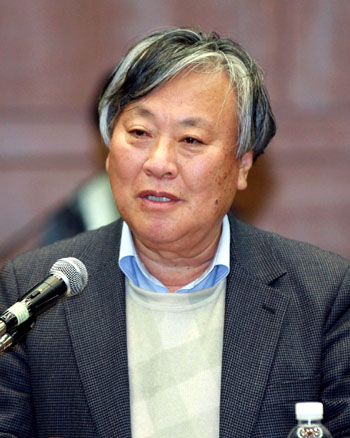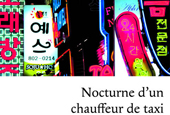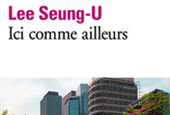
The English version of Yi Mun-yol’s short story “The Golden Phoenix”
The writer joins the ranks of the few novelists who have had many of their works translated and published in numerous languages, including, of course, English, but also French, Italian, Dutch, Chinese and Greek, reaching a worldwide audience.
More than fifty of his novels, whether full-length or short, have now been published for such global readers.
Among them is “The Golden Phoenix,” a 1981 short story. The novel was published in English in 1999, part of a collection of seven short stories, “The Golden Phoenix: Seven Contemporary Korean Short Stories.”
The story frankly discusses the ultimate objective and essence of art, using the conflict and friendship between traditional calligrapher Seokdam and his young pupil Gojuk.
Gojuk is a parentless child, with his father dead and his heartless mother having fled with another man. He has no choice but to live at his uncle’s home. However, as the uncle has to seek asylum in a foreign country, the poor boy is left with the uncle’s old friend Seokdam, who is a calligrapher.
Seokdam wouldn’t have Gojuk under his wing as a pupil since he thinks the way the boy does calligraphy, despite his talented skills, runs against his view of art.
Seokdam’s refusal to teach the youngster puts the two into somewhat of a love-hate relationship. Silently, though, Gojuk starts to polish his calligraphy skills. Unable to turn a blind eye to Gojuk’s natural talent for the art, Seokdam finally accepts the boy, who, however, chooses to leave him in a show of defiance.
As he lives all by himself and keeps doing the art, people start to notice Gojuk’s modern, artistic talent, gaining him sudden fame across the country.
One day, Gojuk feels a sudden sense of emptiness as he thinks that most of his youth has gone nowhere and that all the effort he put into the art has been futile. He then decides to return to his teacher.
“If one can see a golden phoenix rising from his calligraphic works just once in a lifetime, his life has 'got there,’ for sure.” Seokdam repeatedly tells this to Gojuk, but he doesn’t understand it at all.
Gojuk replies, saying, “Even if you can write with one stroke of a brush and see such a golden phoenix soaring from your piece, what’s the use of it?”

Novelist Yi Mun-yol (photo: Yonhap News)
Despite the answer, Gojuk sticks to such a defense and drives the teacher to the end of his patience. Seokdam bursts into anger, throwing an ink stone at him and that’s the last the pair see of each other.
Gojuk leaves Seokdam again, determined that he will never come back. Not caring at all about what happens to the stock of calligraphic work he created over the years, he falls into a promiscuous, dissipated life full of women and alcohol.
After some years, however, Gojuk reaches a point where he feels sick and tired of his out-of-control life. He decides to go back to Seokdam. Before that, however, he heads to a temple at Odaesan Mountain to purify his soul from all unclean things.
There, he happens to see an old, faded mural, a work of art featuring a golden phoenix: a bird with golden wings, a hawk-like head and a human body from the neck down. Then he sees the bird come to life and fly high. He now realizes what the teacher really meant when he talked about the bird.
When he comes back to Seokdam, it’s too late. The teacher has already passed away. In despair, Gojuk gathers all his work and starts to assess each piece. Among the many creations, there’s nothing with which he is satisfied. He realizes that his art is still far from perfect and, more specifically, he is at a point where he can see the golden phoenix.
Gojuk burns all of his work. At that moment, he sees a giant golden phoenix soar from the flames. That night, he breathes his last, and he, too, passes away.
Born in 1948 in Yeongyang-gun County, Gyeongsangbuk-do (North Gyeongsang Province), Yi Mun-yol dropped out of university in 1970 when he was enrolled in the Korean language education program at the College of Education of Seoul National University.
Yi served as a journalist for the Daegu Maeil newspaper until 1977 when he made his literary debut. Now, he serves as a chair professor at the Hankuk University of Foreign Studies.
His major works include full-length novels, such as “The Son of Man” (1979) and “Our Twisted Hero” (1987), as well as collections of short stories, including “The Shadow of Darkness” (1980).
The English-language collection of which this is a part features six other novels: Yun Hu-myong’s “The Girl from the Wind-Whipped House” (1982); Yi Mun-ku’s “The Sunset over My Hometown” (1972); Kim Yong-hyon’s “The Mural” (1994); Choi Yun’s “The Flower with Thirteen Fragrances” (1995); O Chong-hi’s “The Monument Intersection” (1983); and, lastly, Yoon Heung-gil’s “The Rainy Spell” (1978).
By Sohn JiAe
Korea.net Staff Writer
jiae5853@korea.kr



